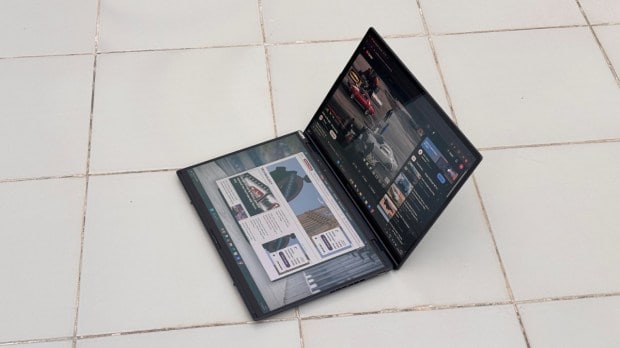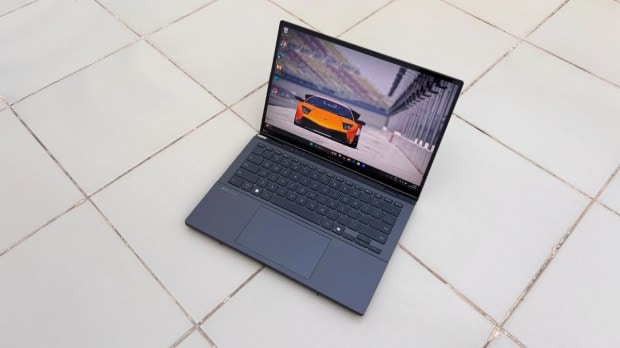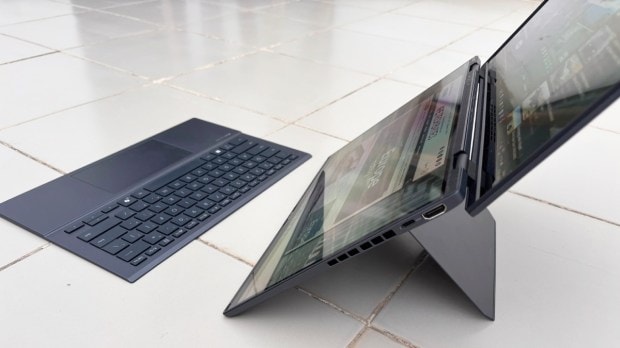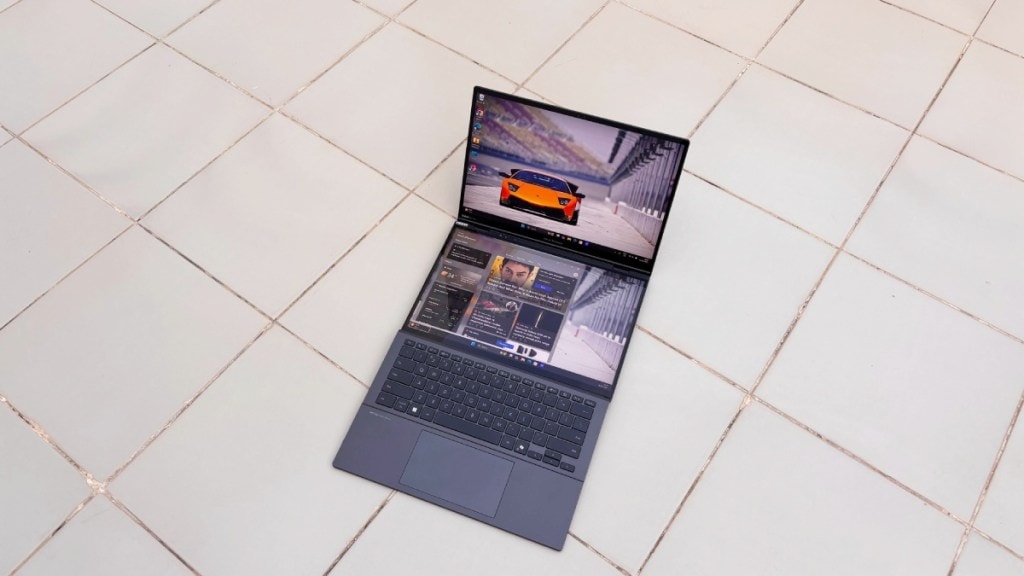For years, the Asus Zenbook Duo series has tried novel ways to offer a dual-screen experience in the conventional laptop form factor. While previous attempts were highly impressive, they didn’t revolutionise the way people used laptops. Asus tried harder and came up with the UX8406 – a clever dual-screen laptop that does take its dual-screen policy too seriously. This laptop replaces the keyboard section entirely with a secondary touchscreen display, thus promising unparalleled space for multitasking.
On paper, this concept seems to click. Two full screens at your disposal in a 14-inch form factor and beefy specs to back it up – what could stop this from changing the way we use computers? With this notion in mind, I hopped on a Asus ZenBook Duo UX8406 of the highest configuration for a few days to find out. Our 2025 variant comes with the top-spec Intel Core 9 Ultra processor and the higher resolution 3K OLED display – two more reasons to spoil us further.
Design and build
The Zenbook Duo 2025 boasts a sleek and remarkably thin profile for a dual-screen device, measuring just 14.6 mm in thickness and weighing in at a highly portable 1.35 kg . This makes it surprisingly manageable for a device housing two displays, challenging traditional notions of laptop bulk. Its most striking design element is the seamless integration of dual 14-inch OLED displays, which allows the laptop to transform into a versatile multi-mode device tailored for diverse user needs. However, do mind the huge bezels around the screens.

The full-size ErgoSense keyboard and touchpad, featuring a snap-on magnetic design, allows users to quickly convert the device from a traditional clamshell laptop to a full dual-screen workstation, with the keyboard placed separately or even used wirelessly. The inclusion of robust Corning Gorilla Glass on both display surfaces significantly enhances durability and scratch resistance. A kick stand underneath allows the second screen to be put up at an angle, thus making life a tad easier. The sleek 65W USB-C charging adapter is another advantage you can count on.
Display
The reason you choose the Zenbook Duo are its two identical 14-inch 3K (2880 x 1800 pixels) Asus Lumina OLED touchscreens. Each display boasts a smooth 120 Hz refresh rate with responsive touch interactions and a crisp visual experience. When expanded, this dual-screen setup effectively expands the workspace to a massive 19.8 inches, whether you use it vertically or horizontally. The OLED panels deliver industry-leading colour fidelity, high contrast with true blacks and exceptional sharpness. With a peak brightness of up to 500 nits, the displays offer excellent visibility even in well-lit environments.
Since this is a touchscreen device, both displays are highly responsive to touch inputs and support a 4096-pressure-level stylus, thus helping with productivity.
Performance
Under the hood, the Zenbook Duo is powered by Intel Core Ultra 9 processor, which comes with a dedicated Neural Processing Unit (NPU) for handling AI tasks like real-time language processing, image generation and intelligent system optimisations. The processor is paired with 32 GB of LPDDR5X memory and a fast 1 TB PCIe 4.0 SSD storage. With Windows 11 on board, this combination provides ample bandwidth for demanding applications, intense multitasking across both screens, and seamless switching.

An advanced cooling system featuring a sophisticated heat spreader, positioned between the motherboard and the OLED panel, keeps the thermals in check. The onboard Intel Arc GPU isn’t as capable as a dedicated Nvidia GPU and hence, you are restricted in graphically intensive tasks. I was able to deal with lighter image editing on the Duo but gaming on this system is not recommended.
As a corporate workhorse, though, the ZenBook Duo clicks. Despite the lack of native support for dual display window management on Windows 11, the second screen makes it easy to deal with multiple Chrome tabs, app windows and more. The live coverage of Apple WWDC 2025 event was made a lot easier – the livestream set on the top display whereas the CMS in Chrome and image gallery on the secondary display made work easy. The keyboard is comfortable to type for a 14-inch machine but needs personal adjustment while using the dual screens together. The speakers, as usual, are terrible and barely enough for video calls – nothing beats the MacBook Pro’s speakers.
Battery
Equipped with a 75 Wh battery, the Asus Zenbook Duo promises good battery figures on paper. However, the real-world tests didn’t live up to the claims (on the Intel drivers and Windows updates available to us during the review period). In the single-screen usage, the laptop conked off after five hours with regular publishing workflow (which includes writing, browsing on Google Chrome, researching documents, watching livestream videos and more). The dual-screen mode reduces the battery life further and requires the charger to go for extended sessions.
Thankfully, the 65W bundled charger fills up the battery to 50 per cent in around 40 minutes, with a full charge taking up to 1.5 hours in the dual screen mode.
Connectivity

As far as connectivity is concerned, you get two Thunderbolt 4 ports (up to 40 Gbps) for power delivery and external 4K monitors/ external GPU units. Additionally, you also get a traditional USB 3.2 Type-A port, a full-sized HDMI 2.1 (TMDS) port, and a standard audio jack for headphones or external speakers. For wireless connectivity, the device is equipped with Wi-Fi 7, which works flawlessly.
Price
The variant we had on review was the top-of-the-line one with the Core Ultra 9 285H processor, costing Rs 2.4 lakh. However, Asus sells a more affordable version with the Intel Core Ultra 7 155H processor, costing Rs 1.6 lakh. India doesn’t get the Core 5 processor variants yet.
Verdict

With two beautiful OLED screens and a competent set of specifications, the Asus Zenbook Duo UX8406 stands as a compelling device for users who prioritise unparalleled multitasking efficiency with more screen real estate. What’s astonishing is that Asus manages to pack two 14-inch screens and a keyboard along with top-notch specs in a package that looks no different than your average Windows notebook. The powerful Intel Core Ultra processor ensures robust and sustained performance, although I’d prefer a beefier Nvidia RTX GPU on board for more versatility on the move. The detachable ErgoSense keyboard is well-executed, too. The laptop also earns brownie points for a good set of connectivity options.
That said, the price is high, even if you consider the base model with the Core Ultra 7 processor. A comparable Apple MacBook Pro M4 offers superior battery performance, similar levels of overall processing might and a better keyboard. The Asus ZenBook Duo, however, steals the show with its beautiful integration of two screens in a cohesive package and for that alone, it earns a recommendation from us.







